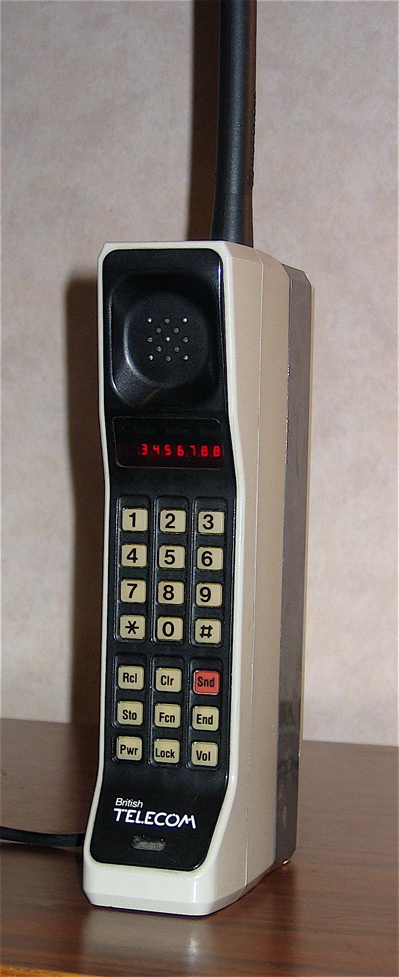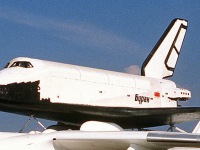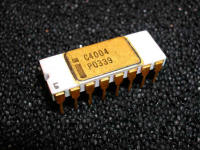
The Motorola DynaTAC 8000,
the worlds first commercially availabvle
cell phone in 1983
©redrum0486
On September 21, 1983, the Motorola DynaTAC, the world‘s first commercially available cell phone received its FCC certification. DynaTAC was an abbreviation of Dynamic Adaptive Total Area Coverage. But, with a price of $3,995 in 1983 ($9,322 in present-day terms) it was a rather expensive while also exclusive gadget.
But, it was not the first mobile phone at all. Actually, in Germany, the Deutsche Reichsbahn (German Railways) already started experimenting with a mobile telephone service along their tracks in 1918, shortly after the suitable radio transmitter was invented. A telephone service in the trains of the Deutsche Reichsbahn was already established in 1926 on the route from Berlin to Hamburg – only available for first class passengers. By 1930, telephone customers in the United States could be connected by radio to a passenger on an ocean liner in the Atlantic Ocean. But this service too was rather expensive.
The first mobile telephone call from a car was made on 17 June 1946 from in St. Louis, Missouri, USA, using the Bell System’s Mobile Telephone Service. Mobile Telephone Service by that time was a rarity with only 5,000 customers placing about 30,000 calls each week. Calls were set up manually by an operator and the user had to depress a button on the handset to talk and release the button to listen. This was followed in 1956 by the world’s first partly automatic car phone system, Mobile System A (MTA) in Sweden. The MTA phones were composed of vacuum tubes and relays, and had a weight of 40 kg. In Germany a similar service followed in 1958. All calls had to be relayed manually and the equipment costs were about half the prize of the car.
Prior to 1973, mobile telephony was limited to phones installed in cars and other vehicles. Martin Cooper, a Motorola researcher and executive, led the team that developed the first hand-held mobile telephone for use on a cellular network. Using a really heavy portable handset, Cooper made the very first call on a handheld mobile phone on April 3, 1973 to his rival, Dr. Joel S. Engel of Bell Labs. He recalled the event later on in the following way:
“As I walked down the street while talking on the phone, sophisticated New Yorkers gaped at the sight of someone actually moving around while making a phone call. Remember that in 1973, there weren’t cordless telephones or cellular phones. I made numerous calls, including one where I crossed the street while talking to a New York radio reporter – probably one of the more dangerous things I have ever done in my life.
On 6 March 1983, the DynaTAc mobile phone was launched on the first US 1G network by Ameritech. Its development costs hit about $100m and it took over a decade to really hit the market. The phone had a talk time of just half an hour and took ten hours to charge. Consumer demand was strong despite the battery life, weight, and low talk time, and waiting lists were in the thousands.
TEDxSanDiego – Marty Cooper – The Power Of Wireless Social Networking, [7]
References and Further Reading:
- [1] History and Evolution of Cell Phones
- [2] Agar, Jon (2004). Constant Touch: a Global History of the Mobile Phone. Cambridge: Icon.
- [3] From Brick to Stick: A History of Mobile Phones at Wired
- [4] Tim Berners-Lee and the World Wide Web, SciHi Blog
- [5] Taking All Moving Parts out of Television – Philo Taylor Farnsworth’s Electronic TV, SciHi Blog
- [6] Johann Carolus and the First Newspaper, SciHi Blog
- [7] TEDxSanDiego – Marty Cooper – The Power Of Wireless Social Networking, 2011, TEDx Talks @ youtube
- [8] Reed, Brad (May 9, 2011) Meet the guy who made the first cellphone call 40 years ago today, Network World.
- [9] Teixeira, Tania (23 April 2010). “Meet the man who invented the mobile phone”. BBC News.
- [10] Timeline of mobile phones, via Wikidata






Pingback: Whewell’s Gazette: Year, 2 Vol: #11 | Whewell's Ghost